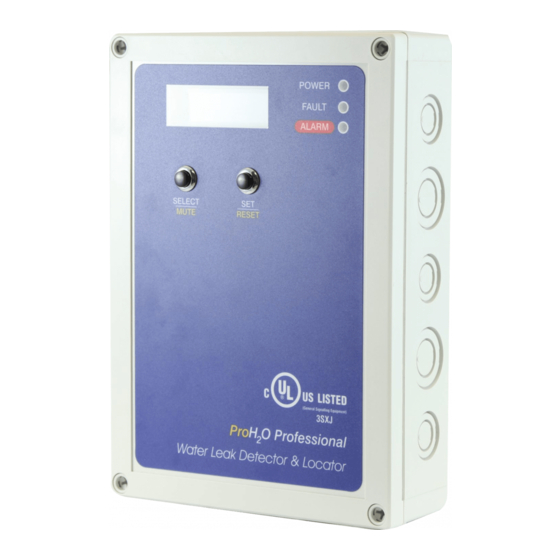
Advertisement
Quick Links
ProH2O Water Leak Detection Application Guide
IMPORTANT GUIDELINES
The ProH2O Water Leak Detection Systems are ideally suited for early warning of water leaks in a wide variety
of applications. Planning and correct placement of the ProH2O sensor cable will maximize the effectiveness of
the system to detect water leaks and trigger an alarm. Before starting the installation identify all areas where a
water leak is likely to occur and make a note of these areas in order to plan placement of the cable.
In all applications of water leak detection it should be noted that the ProH2O sensor cable
MUST come into contact with sufficient amount of water in order to trigger an alarm. Therefore
before installing the sensor cable check either visually or by experiment to ensure water will
• Ensure the product is installed, commissioned and maintained by persons according to good
engineering practices and authorities having jurisdiction.
• It is important at all times to keep the detection cable clean and free from dust, debris and other
contaminants that may soil the cable, especially during installation.
• Ensure any major construction work has been completed and signed off before installing the detection cable
• Periodically inspect the detection cable. The cable should be clean and free of dust or other contamination.
The inspection interval should be no greater than 12 months.
• Ensure the detection cable is thoroughly dried out after a leak has occurred.
• A selfadhesive or screwtype Uclip should be used to secure the detection cable to the mounting surface
without lifting it or creating an air gap between the surface and cable.
• Do not cut and reterminate the detection cable.
The connections have been factory fitted and are unservicable.
• Do not paint the detection cable.
• Do not put the detection cable under excessive tension.
Maintain some slack in the detection cable when laying it out on surfaces.
• Do not bend the detection cable less than the minimum bend radius of 25mm (1")
• Avoid laying the detection cable in areas where heavy taffic may result in damage.
• Do not solder or weld around the detection cable. Flux or other conductive contaminants will prevent the
detection cable from operating correctly.
• Do not crush the detection cable.
Web: www.waterleakdetection.com Email: info@thermocable.com
Tel:
flow to where you intend to lay the cable.
Document 520/001 Rev 2.2 Dec 2013
+44 (0)1274 882359
Fax:
+44 (0)1274 882229
Page 1 of 10
Advertisement

Summary of Contents for Thermocable ProH2O
- Page 1 ProH2O Water Leak Detection Application Guide IMPORTANT GUIDELINES The ProH2O Water Leak Detection Systems are ideally suited for early warning of water leaks in a wide variety of applications. Planning and correct placement of the ProH2O sensor cable will maximize the effectiveness of the system to detect water leaks and trigger an alarm.
-
Page 2: Other Applications
Web: www.waterleakdetection.com Email: info@thermocable.com Tel: +44 (0)1274 882359 Fax: +44 (0)1274 882229 ProH2O Water Leak Detection Application Guide Typical Applications for Water Leak Detection • Data Centres/Computer rooms Detect leaks underneath raised flooring • Fire Sprinkler systems Ensure the integrity of pipework/tanks •... -
Page 3: Technical Data
+44 (0)1274 882229 ProH2O Water Leak Detection Application Guide SENSOR CABLE OVERVIEW ProH2O Sensor Cable is a linear sensor for the detection of water leaks. When water comes into contact with the detection cable a controller can detect changes in the electrical characteristics of the cable and signal an alarm or other action. -
Page 4: Sensor Cable Installation
Area Protection Standard application ProH2O sensor cable is ideally suited to detecting leaks over a wide area such as underneath a raised floor or similar applications. The sensor cable should be laid around the perimeter of the room and then spaced equally across the remaining floor space as shown below. - Page 5 SENSOR CABLE INSTALLATION Leak detection around pipes ProH2O detection cable can be used to provide early warning of leaks from pipework, valves and similar equipment. It is important to maintain the surface contact between the pipe and detection cable. A maximum spacing of 150mm (6") is recommended between cable ties when the detection cable is...
- Page 6 Water Tanks Protection ProH2O Sensor cable can be used to protect water tanks in a roof space where there is a possibility of leaks going unnoticed for extended periods. Typical examples include header tanks or expansion tanks in the loft of a house or in the roof space of an office building.
- Page 7 Air Conditioning (or HVAC) Units (Indoor use) ProH2O Sensor cable can be laid around air conditioning units and the associated drip trays to provide an early warning of a malfunction or damage to the connecting equipment. It is important to ensure the sensor cable will remain dry during normal operation of the air condition unit.
- Page 8 SENSOR CABLE INSTALLATION Securing the sensor cable It is important to correctly secure the ProH2O detection cable in order to maximize the possibility of water coming into contact with the water sensitive cores within the cable. Figure 5 below shows the recommended mounting clips used to secure the sensor cable.
- Page 9 The detection cable can be cleaned with a damp cloth or by washing the cable in water. Once cleaned the cable will need to be dried before the ProH2O system can be used. Do not use solvent based cleaners on the cable.
- Page 10 7. How much water is required to trigger an alarm? The amount of water required to trigger an alarm varies depending on which ProH2O controller the sensor cable is connected to. Please refer to the ProH2O Module documentation (Document No. 550/001) or ProH2O Professional documentation (Document 500/001) for more information.